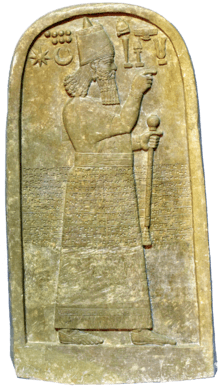Adamu (Assyrian king)
Adamu (Akkadian: 𒀀𒁕𒈬, romanized: A-da-mu) was an early Assyrian king, and listed as the second among the, "seventeen kings who lived in tents" within the Mesopotamian Chronicles.[1][2] The Mesopotamian Chronicles state that Adamu succeeded Tudiya.[3] The Assyriologist Georges Roux stated that Tudiya would have lived c. 2450 BCE — c. 2400 BCE. The earliest known use of the name “Adam” as a genuine name in historicity is Adamu.[4] As in his predecessor's case, virtually nothing is otherwise known about Adamu's reign or him personally; his existence remains unconfirmed archaeologically and uncorroborated by any other source.
| Adamu | |
|---|---|
| Monarch of Azuhinum | |
| Reign | fl. c. 2400 BCE — c. 2375 BCE |
| Predecessor | Tudiya |
| Successor | Yangi |
Geopolitical context
Adamu is succeeded on the Assyrian King List by Yangi and then a further fourteen rulers: Suhlamu, Harharu, Mandaru, Imsu, Harsu, Didanu, Hana, Zuabu, Nuabu, Abazu, Belu, Azarah, Ushpia and Apiashal. Nothing concrete is yet known about these names, although it has been noted that a much later Babylonian tablet listing the ancestral lineage of Hammurabi of Babylon, seems to have copied the same names from Tudiya through Nuabu, though in a heavily corrupted form. The earliest Assyrian kings (such as Adamu), who are recorded as “kings who lived in tents”, had at first been independent semi-nomadic pastoralist rulers, moreover; Assyria was originally an oligarchy rather than a monarchy. These kings had at some point become fully urbanized and founded the city-state of Assur.[5]
The Assyrians and Sumerians had become subject to the Akkadians, centered in central Mesopotamia c. 2400 BC. The Akkadian Empire claimed to encompass the surrounding, “four corners of the world”. Assyrian rulers had become subject to Sargon of Akkad and his successors, and the city-state of Assur had become a regional administrative center of the Empire, implicated by the Nuzi tablets.[6]
The region of Assyria, north of the seat of the empire in central Mesopotamia, had been known as Azuhinum in Akkadian records.[7] Towards the end of the reign of Sargon the Akkad, the Assyrian faction had rebelled against him; “the tribes of Assyria of the upper country—in their turn attacked, but they submitted to his arms, and Sargon settled their habitations, and he smote them grievously.”[8]
| Preceded by Tudiya |
Monarch of Azuhinum fl. c. 2400 BCE — c. 2387 BCE |
Succeeded by Yangi |
See also
- Assyria
- Assyrian continuity
- Assyrian people
- Early Period of Assyria
- List of Assyrian kings
- Timeline of the Assyrian Empire
References
- Glassner, Jean-Jacques (2004). Mesopotamian Chronicles. Society of Biblical Literature. p. 137. ISBN 1589830903.
- Meissner, Bruno (1990). Reallexikon der Assyriologie. 6. Berlin: Walter de Gruyter. p. 103. ISBN 3110100517.
- Roux, Georges (1992). Ancient Iraq. Penguin Books Limited. ISBN 9780140125238.
- Hamilton, Victor (1995). The Book of Genesis, Chapters 1 - 17. Wm. B. Eerdmans Publishing. ISBN 9780802825216.
- Saggs, The Might, 24.
- Malati J. Shendge (1 January 1997). The language of the Harappans: from Akkadian to Sanskrit. Abhinav Publications. p. 46. ISBN 978-81-7017-325-0. Retrieved 22 April 2011.
- "Prehistory and Protohistory of the Arabian Peninsula: Bahrain". M. A. Nayeem. 1990. p. 32.
- Malati J. Shendge (1 January 1997). The language of the Harappans: from Akkadian to Sanskrit. Abhinav Publications. p. 46. ISBN 978-81-7017-325-0. Retrieved 22 April 2011.
